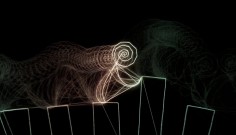PHILIPP ARTUS
snail trail
source: neofundi
Known as snail trail, this short film laser animation, designed by German artist Philipp Artus is based on the process of exponential acceleration which one can observe at different levels. I found this quite intriguing as he uses evolution of life as his conceptual platform for the project, it reflects the procedure of time-based measurements. These measurements took 3 billion years for its slow growth in evolving species whereby a population explosion seems to occur during the process of the “Cambrian period”. As the tools of human beings during the Stone Age only progressed minimally, contrasts between the rapid cultural development during the “Holocene” era translated the idea into a similar acceleration processes which were generated by the exchange of information through the internet. From animations side of life, the exponential spiral on a snail shell appears like a speck in time, it is done very well in its use of referring to the above mentioned information, I didn’t really understand until I watched the animation. Have a look and let me know what you think.
.
.
.
.
.
.
source: designboom
german artist philipp artus has developed ‘snail trail’, a short film laser animation based off processes of exponential acceleration,
which can be observed at different levels. using evolution of life as the conceptual platform for the project, it reflects on the procedure
of time-based measurements, where after over 3 billion years of slow growth in evolving species, an population explosion seems
to occur during the cambrian period.
as tools of human beings progress relatively minimally during the stone age, a contrast between the rapid cultural development
during the holocene era, translating the idea into a similar acceleration process which is generated by the exchange of information
through the internet. from the perspective of the animation, the exponential spiral on a snail shell appears like a speck in time.
.
.
.
.
.
.
source: etapes
L’artiste allemand Philipp Artus est le créateur de “Snail Trail” une installation lumineuse qui retrace le parcours d’un escargot dont les pérégrinations l’amènent à revenir à son point d’origine. Le phénomène est traduit par une projections 360° sur un écran cylindrique en matière phosphorescente. Ainsi, petit à petit les traces laissées par la diffusion de lumière disparaissent. Philipp Artus livre également une courte vidéo d’animation qui reprend le concept de la sculpture laser.
.
.
.
.
.
.
source: lamanufacturera
Esta serie de increíbles esculturas de láser titulada ” Snail Trail ” fue diseñada por el animador alemán Philipp Artus, quien a través de un cortometraje nos presenta a una especie de caracol cíclico que simboliza el invento de la rueda en un viaje a través de las formas de este molusco. Se le pueden atribuir conceptos como el aceleramiento cultural, la relación entre naturaleza y cultura, la evolución de la vida, la energía, el ritmo, los ciclos, etc.
Artus utilizó una técnica mixta que combina tanto la tecnología análoga como la digital, emparentando a estos dos recursos de una manera eléctrica y llena de color. Primero, él creó una animación en 3D del caracol utilizando 3ds Max; luego la proyectó con láser en una superficie fosforescente que registra el brillo, grabando fotograma por fotograma con el programa Dragonframe Stop Motion. Por último, fue completada en la post producción con la ayuda del software After Effects. La idea era que tuviera un concepto digital pero que también diera la sensación de estar hecha a mano.
La apariencia e impresión de ‘ Snail Trail ‘ fueron inspirados por elementos que van desde la naturaleza, Leonardo da Vinci, hasta el movimiento de las patinetas y el surf; mientras que el diseño del sonido estuvo a cargo del bajista Madalena Graca, y se compone por los drones ambientales ( estilo de música minimalista que consiste sonidos sostenidos o clústers repetidos en el tiempo, también conocido como pedal ) así como por los beats electrónicos del post – dubstep, intentando empatar y armonizar dichos sonidos contrastantes.


